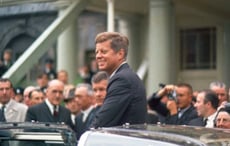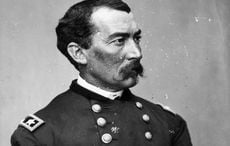The news that the Irish Famine ship the Jeanie Johnston will sail again brings back a flood of memories.
It will be made ready for the Tall Ships race in 2012 which stops in Ireland. It is currently a tourist attraction in Dublin harbor.
It sailed to America in 2003, a perfect replica of a ship of the same name which left Kerry on 16 trips to American during the Famine.
I went onboard the Jeanie Johnstone back in Dublin in 2003 before it left for America. The following are my impressions.
"You simply cannot board this ship without the ghosts of your past and ancestors becoming vividly alive. It is a humbling and emotional experience akin to walking around the hugely successful famine cottage recreation at the tip of Manhattan.
There were massive cost overruns on the creation of the Jeanie Johnston, and even government inquiries into exactly how it took so long and was so expensive to build. There were those who said it would never be finished, and even more who thought it shouldn’t be.
To many it became a white elephant, a great idea gone awry. They were gravely mistaken.
The Jeanie Johnston provides a missing link in the history of the millions of Irish coming to America. For the first time we Irish Americans can go on board a famine era ship and see, feel and hear the sounds of what that incredible voyage across the North Atlantic must have been like.
We are discovering the world of those who gave everything to come to America to begin the great trek which has now resulted in over 40 million of Irish descent in our land.
The Atlantic was known as the “bowl of tears” because of the number of famine wracked Irish who died on the trip and who never saw the Fresh Land, or Oilean Ur as they referred to it in Gaelic. Now you can see and understand what the seafarers faced when they boarded in their millions at Irish ports.
The original Jeanie Johnston made its maiden voyage on April 24, 1848, right at the height of the Famine. It made 16 voyages in all to North America and carried over 2,500 souls fleeing the famine.
The coffin ships took up to 40 days to reach their destinations in North America. It was a voyage for many similar to what African Americans faced aboard the slaving ships. African Americans came to America in chains, the Irish in coffin ships. No other ethnic groups can remotely compare with their experiences.
It is a humbling and dramatic experience to board the Jeanie Johnston, as I did this week in Dublin, and experience the wave of emotion that whips up in you when you encounter first hand what people faced.
Just a few hundred yards away from where the ship is docked, whether by accident or design, is the Dublin famine memorial, which depicts several painfully thin ghost like figures. One is carrying a sick child strapped across his back, another barely able to walk because of the hunger, making their way to a famine ship. You can see the masts of the Jeanie Johnston in the near distance and you can imagine from the depiction of these starving emigrants, just how awful an experience lay ahead of them.
Once on board the ship it is the steerage section, where they lay six four to a six-foot square bunk, with beds stacked on top of each other, which really hits home.
There is a record of a letter from a family who made it to America telling relatives who were coming over that they should try immediately to secure a top bunk when they boarded. The reasons were clear. Passengers were often violently seasick and if you were on the lower bunks you often suffered the consequences.
There are life-sized models of emigrants lying in the bunks. You see one family with the mother and father and two children lying between them crammed into the six-foot square space.
You see and hear the racking cough of a female emigrant, showing the first signs of cholera, as the ship’s doctor tries to tend to her. Mid 19th century medicine was no match, however, for such diseases which ran rampant through many ships.
The recreation of a family parting for the last time on the Quay in Tralee is also heart rending.
The full impact of what famine emigration meant hits home. Those on board would never return, dead or alive, unless they were incredibly lucky.
Parents, brothers, sisters, children were all saying goodbye to country kith and kin for the last time. They must have been very frightened.
Most were peasants who had grown up knowing nothing of the sea. Surprisingly, perhaps, the largest group was single women between 16 and 30 who were facing indescribably poverty and privations at home.
Entire families fleeing the famine also made up much of the passenger load. One can only imagine what the parents must have felt on first entering the dimly lit, stench filled hold.
For many the voyage must have been misery indeed. As the Jeanie Johnston shows there was no separation of the sexes, no privacy at all in the cramped holds, and always the fear of disease and death stalking the passengers.
How they all came up with the fare of 3 pounds and 10 shillings, a huge sum for the time, will always remain a mystery.
They must have sold everything but the scraps of clothes on their backs. They were required to bring their own food, as well as their own cooking utensils, but many were unable to do so.
As the Jeanie Johnston shows, there was just one stove for all the passengers who could number as many as 250. Mealtime was dependent on when they reached the stove — it could be as early as six in the morning or 11 at night.
In bad weather many families went hungry and were reduced to eating raw flower and meal. The ship carried a pittance of food for passengers.
Regulations called for 2 1/2 pounds of bread or biscuits a week, one pound of flour, five pounds of oatmeal and 21 quarts of water for the entire ship.
Toilets, of course, were non existent. Buckets were shared beneath deck and the contents thrown overboard. Once can only imagine the stench and the disease that inevitably followed.
There is every indication that the owners of the Jeanie Johnston were actually compassionate men for their time.
A ship’s doctor, Richard Blennerhassett, seems like a remarkable man who saved numerous lives onboard the ship.
. A testament to his ability is that not a single passenger of the 2,500 the Jeanie Johnston carried died on board the ship. Ironically, the doctor himself would succumb to cholera on another ship at the young age of 36 in 1854.
The original ship was reconstructed, using modern safety features, by Fred M. Walker, chief naval architect at the National Maritime Museum at Greenwich near London.
The ship had enormous problems, both financial and passing its sea trials.
Since it has arrived, however, it has become a major tourist attraction. On the day I visited hundreds of parents were showing their children around the ship and explaining to them about the Great Irish Famine. I cannot think of a greater gift to give a child, either in Ireland or America, than explaining the past in such a vivid way.
The story of the famine was buried, attempts made to forget about it many times since it occurred. Even for many of those who survived there was a sense of shame about what happened, and a refusal to face the consequences of the greatest population movement of the 19th century.
Today, however, as the Jeanie Johnston and the famine memorials all over the U.S. show, we are once again reclaiming that past, understanding it and passing our knowledge on to our children. The Jeanie Johnston will be a vital link in that chain.
We know why the famine tossed left Ireland and what they faced once they reached America’s shores. There are ample writing and historical tomes on the reasons behind emigration and the extraordinary ordeal the millions faced once they made it to the New World. Indeed Gangs of New York, the Martin Scorsese movie, is at heart a magnificent portrait of how the Irish overcame that extraordinary adversity and triumphed.
The Jeanie Johnston is a missing link we have all been waiting for, a treasure that illuminates one of the darkest chapters in any country’s history. We should be grateful it was built. Compared to green beer, tooraloora songs and 40 shades of green, it is as authentic a vision of old Ireland as exists."




Comments